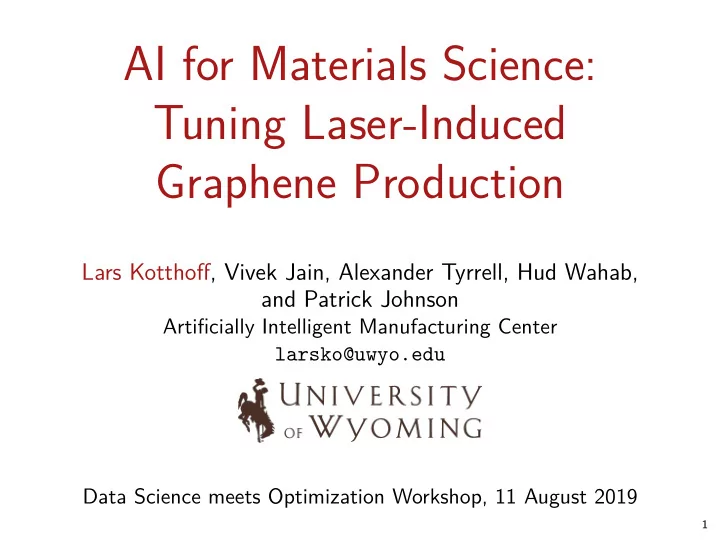

AI for Materials Science: Tuning Laser-Induced Graphene Production Lars Kotthofg, Vivek Jain, Alexander Tyrrell, Hud Wahab, and Patrick Johnson Artifjcially Intelligent Manufacturing Center larsko@uwyo.edu Data Science meets Optimization Workshop, 11 August 2019 1
Automated Parameter Tuning workings required improve performance 2 ▷ treat tunable process as black box – no knowledge of inner ▷ intelligently and iteratively select parameter settings likely to ▷ mature techniques used in many areas of AI
Optimizing Graphene Oxide Reduction material results 3 ▷ reduce graphene oxide to graphene through laser irradiation ▷ allows to create electrically conductive lines in insulating ▷ laser parameters need to be tuned carefully to achieve good
From Graphite/Coal to Carbon Electronics 4 Overview of the Process
Experimental Setup 5
Evaluation of Irradiated Material 6
Morphology of Irradiated Material 7
Tuned Parameters 8 ● ● ● ● ● ● ● 6 ● ● ● ● ● ● ● ● ● ● ● ● ● ● ● ● ● ● ● ● ● ● ● ● ● ● ● ● ● ● Ratio ● ● ● ● ● ● ● ● ● ● ● 4 ● ● ● ● ● ● ● 2 0 10 20 30 40 50 Iteration
Tuned Parameters evaluations) machine learning 9 ● ● 6 ● ● ● ● ● ● Ratio 4 + Prediction 2 • Actual 50 um 50 um 0 2 4 6 8 Iteration After 1 st prediction During Training ▷ improvement of factor of two over best result in literature ▷ good results even with small amount of initial data (19 ▷ code can be used by domain experts with no background in
Explored Parameter Space 10 48 47 12 18 29 1 5 9 7 21 17 35 6 37 42 22 19 31 38 33 28 25 10 32 11 13 2 27 34 8 16 20 30 39 Ratio 6 3 44 43 46 45 14 26 24 40 4 4 36 41 ● 23 ● 15 ● ● ● ● ● 2 ● ● ● ● ● ● ● ● ● ● ● ● ● ● ● ● ● ● ● ● ● ● ● ● ● ● ● ● ● ● ● ● ● ● ● ● ● Parameter Space
Outlook performance learned 11 ▷ application to other materials ▷ more in-depth investigation of Bayesian Optimization ▷ inform understanding of process by what surrogate model has
Summary 12 ● ● 6 ● ● ● ● ● ● Ratio 4 + Prediction 2 Actual • 50 um 50 um 0 2 4 6 8 Iteration After 1 st prediction During Training
Recommend
More recommend